The Origin of Violin Musical Instruments
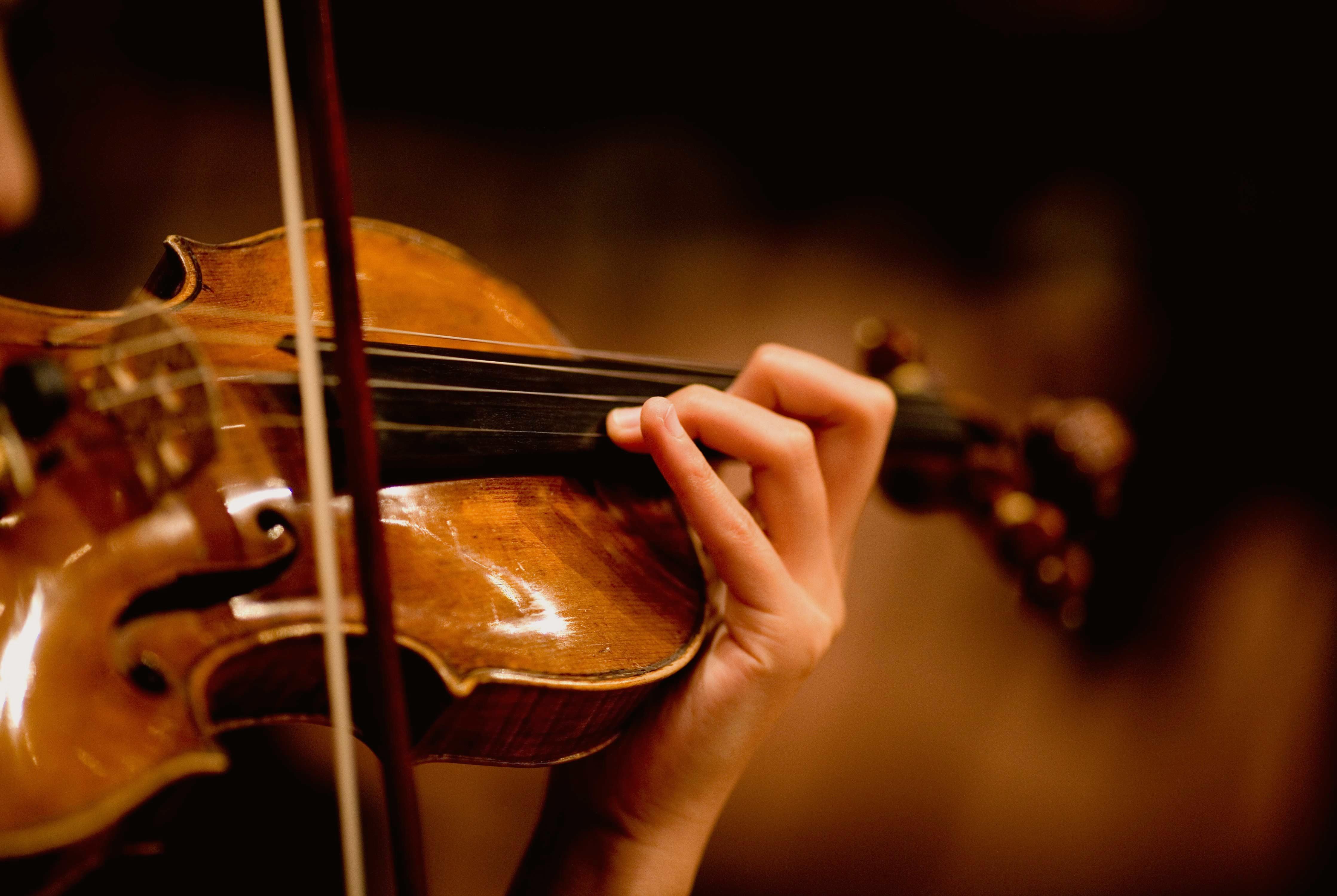
The violin belongs to one of the Violin groups, which consists of: small violin, medium violin, big violin and violin bass, the difference lies in its size, but the way it sounds and the resonance is the same.
The violin is played by a swipe, commonly called: a string instrument. The origin of stringed instruments includes a long time in the history of mankind, along with the spreading of culture and historical change, therefore in different areas there may be different titles for a single musical instrument, or it could be a similar designation but a musical instrument different, slowly along with the endemic situation then it has developed into a variety of musical instruments.
Birth of the Violin
According to the ancient records of the Aryans in India, in 5000 years ago, king Ravana of Sri Lanka had created a musical instrument using a bow-string, the Ravanastron.
Then Ravanastron spread to Afghanistan and Persia, at the beginning of the 1st century. During the time of the Tokharist kingdom in Afghanistan, the shape of the musical instrument was transformed into a Pipe (Chinese stringed instrument), flat topped, its back from a whole wood carved into concave, rather smooth, its tone and resonance rather large. In the 7th century it spread to the Arabian territory and when the golden age of Islam its name was changed to Rebab.
Spread to Europe
Around the 8th century, along with the expansion of Islamic influence, Rebab entered Spain, then Spain under the rule of the Aragon dynasty. The Spaniards refer to the instrument as Rebec or Rebeca. At the same time also entered Rome, Greece, Eastern Europe and Italy. In medieval Europe, the development of stringed instruments was Italy, Germany and France, although the origins of stringed instruments were not in Europe, but had been spread and triumphant in Europe. Stringed musical instrument that originally entered into Europe consists of 2 kinds, namely: Vertical grip and Grip on the arm.
Violin with vertical grip is the way of preliminary presentation of string instrument. From the beginning of the Arab Rebab to Rebeca, until after hundreds of years of change from Rebeca to Viol. Everything was played with a vertical, until the 18th century replaced with the popularity of the violin. However, the way the vertical grip until now can be maintained in various regional musical instruments, for example: Hu Qin from China, Gadulka from Eastern Europe, Sarangi and Sardi from India, Morinchur from Mongolia and others.
The violin by means of grasping over the arm is played by placing Rebeca on the back of her hand or clamped under the jaw, possibly affected by Lyra from Egypt. Also due to the influence of the performances of the European poets' performances by nomadic artists, that is the pioneer/early form of modern violin. Viol appears first 1 century than the Violin. Since the handle is vertical, it is not the first form of the violin. Both instruments exist together for 2 centuries. Viol's voice is clear and sweet, soft and elegant, which is why it is usually played in high-end community forums, such as inside the Palace. While the violin volume is rather large, the voice is brilliant and beautiful, can be played between the strong and weak level, then it is more suitable with wide forums, such as meeting hall and Ball Room Hotel and so forth.
Around the 17th century (1650), obviously Biola is favored by the world, the needs and position of Violins since then surpassed Viol.
The Appearance of the Violin
Under cultural exchanges and blows, the earliest modern violins appeared in the 16th century (circa 1520) in Northern Italy. The 16th century was the most glorious moment of the Renaissance.
With the background of the Renaissance, Gradually the Violin leads to today's modern form, its delicate manufacture, its design process/technology in accordance with technology and aesthetic principles. Moreover, his beautiful voice and loud, strong and agile features highlight the instruments of today. Coupled with further development by Cremona and 3 clans of the most famous violinists, namely Amati, Stradivari and Guarneri.
Until now, their made to order violin is still a conquest of modern collectors, still today recognized as the best violin in the world. Modern violin makers are keen to seek reform and renewal, but they are always incapable of exceeding the design of the precursor generation.
Although there are a number of personal styles or small changes, but can not be separated from the original pattern. That is why there is a thought, the violin is a thing that has been maximal in the history of human technology. The technique of play and the position of the violin at the end of the 16th century has not reached its peak. However, the development of musical instruments follow and complement each other between the player and the composer. In the mid-seventeenth century, composers began to pay special attention to a particular musical form for performances, such as violin music or acoustic music, slowly violating the role of Viol.
Italian composer, Monteverdi officially incorporated the violin into his show and has invented many techniques of playing the violin, producing even richer tones and violin sounds. Marini has written many solo music for violin. While Corelli is referred to as "The Father of Modern Violin Techniques" is a professional performing expert is also a composer. He started creating violin style Sonata and 12 great Philharmonic Orchestra concerts (big concerts are the early form of concerts).
Due to the presence of the composers as mentioned above which makes the development and position of the violin has advanced and rapidly. Also has influenced the composers of classical streams such as: Bach, Georg Friedrich Handel, Mozart and others.
In the days of Barocco due to the progress of violin music, the music gradually escaped the way the staging of acoustic music of the church. And formed indoor music performances. Until the end of Barocco, the scale of the orchestra and its complexity grew, and the musical performances of the musical instruments were also increasingly complex and varied. The violin technique in the early 19th was also brought to its peak by the Italian violinist Paganini.
Log into China
The Ravanastron mentioned in the beginning of this paper, (at first) has not yet spread to China. Some go to India to Jia Kum. Finally, in the thirteenth century, it only entered China, it was the Hu Qin horse of the Song Dynasty. After 400 years, the new modern violin along with the entry of missionaries and merchants of the Qing Dynasty came to China.
The initial spread of the violin was limited to missionary activity within the palace, after Candu's war, the violin through a large number of missionaries following new strangers seeped into Chinese society. Churches and seminar schools flock to the Philharmonic Orchestra music group and have educated and nurtured many western musicians.
Until 1927 Cai Yuanpei and Xiao Yumei in Shanghai established a state music center. This is the earliest high-level music school built in China, and since then has begun its own educational performance personnel.
Violin Components and Functions
Knowing the shapes and components is the easiest way to master the violin. Basically, this violin is made of wood type Spruce, which is a type of pine wood carved so that it is symmetrical. The violin is divided into several parts, on the neck of the violin having a peg box, pegs that set each string, finger board and bolt or saddle. While the violin body has many components such as purffling, indentation C, hole F, bridge violin (bridge), violin tail, some additional tools on the violin tail when needed, pins and straps, and chin buffer.
For more details, here are the violin parts.
The Violin Parts
In the picture above, we can see that the violin has many parts. Below, we will discuss the parts one by one.
Scroll / Head Violin

The scroll is shaped like a neat roll on the end of a violin. This section is rarely known by most people. When observed this tool does not seem to work, as if the scroll is only as part of which was made to beautify the shape of the violin only. However, this section actually serves to strengthen the finger board.
Pegbox
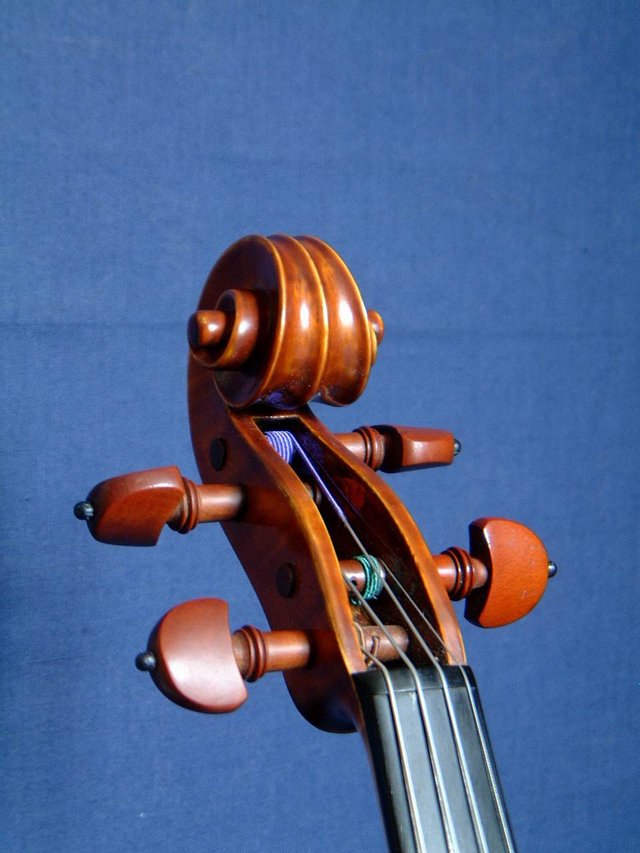
As with guitars, pegbox serves as a string binder, and serves as a tone control in each string. There is an empty space on the
violin head with a rectangular shape ynag usually called pegs. This tool is useful to make it easier to insert the strings attached to the end of the peg, as well as the fourth silent place pegs.
Neck

On the left side of the violin, there is a violin neck as a fulcrum. The tool is made of maple wood type. The type of wood is a type of wood that is known to have good quality. Neck serves to hold the finger board and unite the body and the head of the violin.
Finger Board
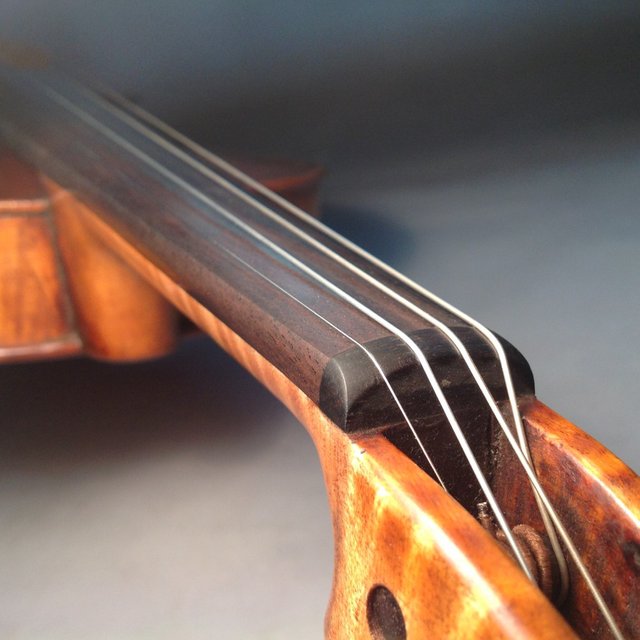
When we want to play the violin, the fingers of the left hand press the finger board to produce the tone we want. This section is made of ebony type wood painted in black. This type of wood is often used in the making of violins because of the durability, hardness, and attractive nature of wood. In order to easily distinguish between the neck and the finger board, usually marked with black. Its function is to place the fingers of the left hand and pressing the notes on the finger board.
Upper Bout

Source
Upper bout is the top of the violin body.
Waist (C-Bouts)
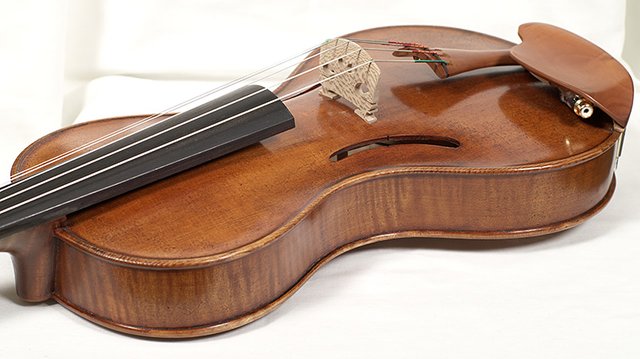
Source
The violin wound/curvature of the C-shaped violin is located on both sides to the side of the violin body. Its function is to provide an empty space for the violin bow in motion.
F-Holes
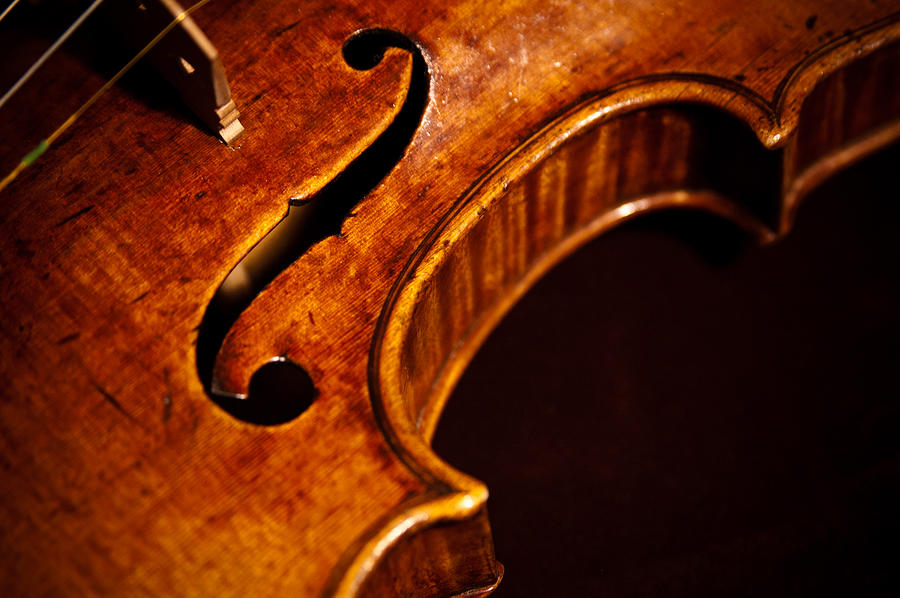
The earpiece, called F-Hole, serves to influence the elasticity of sound. In addition, as a hole breathing violin when the air resonates inside. The second hole F is located at the front of the violin body, which, when viewed in one of the left holes, is a pole mounted parallel to the bridge.
Bridge

This part is very important role, shaped thin wood that serves to support the string. The bridge is made of maple wood that is curved to facilitate the friction. In order for the separation of strings to have a frictional distance, then this section is made with great care. The arch on it is useful to hold the strings at a certain height distance. This bridge stands perpendicularly about 90 degrees with a violin body. The bridge serves to deliver vibrations of sound and strings to the body of the violin, so that it is stored by means of sandwiched or right in the middle of two F holes that form a 90 degree angle.
Fine Tuner
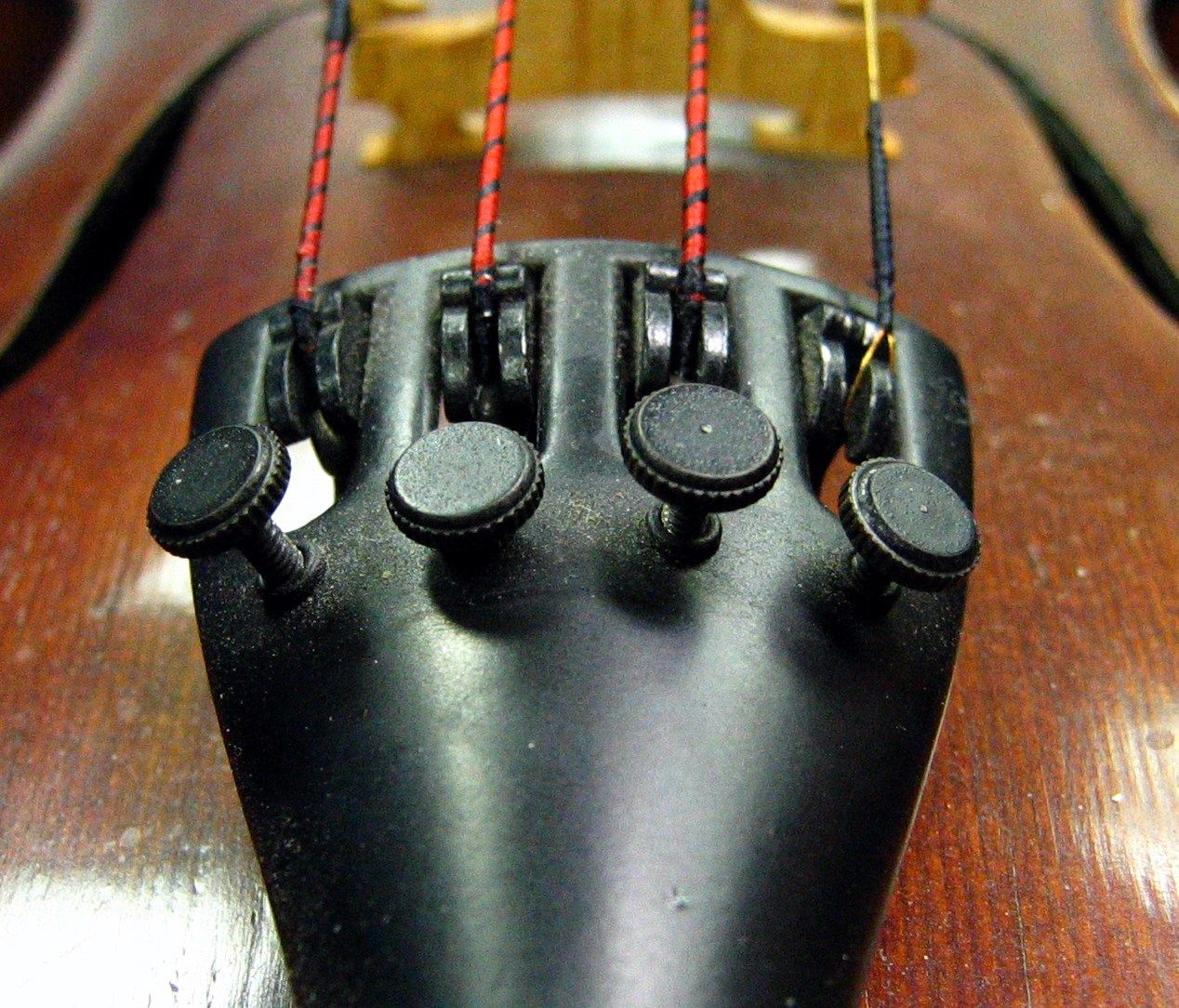
As the name implies, this fine tuner is the part that serves to tune the sound of the violin which when played variations of his voice only a few cent. So if our violin only fals half-tone -1 tone (1-2 seminode), we can tune from here.
Tail Piece
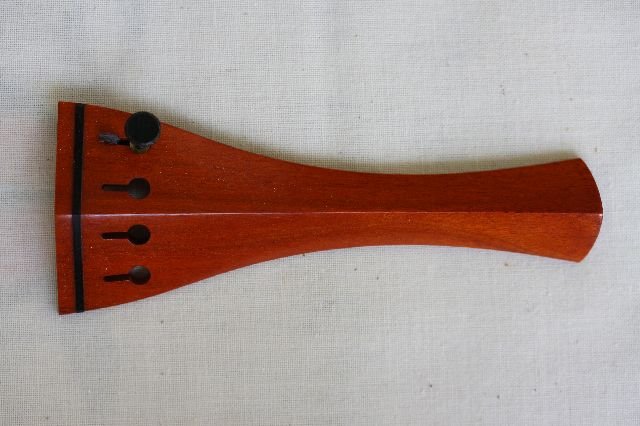
Source
The lower part of this violin is the part that is also used to tie the other end of the string, but it also serves as a place to put the fine tuner.
The section consists of four holes each of which holes as a place of tucked strings that are moored from the lower end. Often for the E string is also given an additional setter to make adjustments easier, but for other strings can also be fitted with this additional setter. Some players sometimes do not want to add an additional setter because it can aggravate the violin and change the sound quality produced.
Chinrest
This is the part where the necks clamp the violin. For beginners there is usually a kind of barrier that helps sustain the added load in this section so that the fiddle can be held tightly.
Bow Violin

Made of a wooden stick between one end to the other is fitted with strands of horse hair. At the bottom end there is a kind of screw that is used to tighten when it will be played or loosen it when it will be stored. There is a handle for the thumb and other fingers near the screw. The hair used for this fiddle is usually taken from the white horse's hair, and its hair is always golden white, although the cheaper ones use synthetic fibers. The bow of the string will be more stable, controlled and not easily separated when the string arc is often used or swiped, it also helps the vibration technique. The logs used are usually made of Pernambuco wood for best results or of cheaper Brazilian timber, and cheap arcs usually use glass fiber. Recent innovations have enabled carbon fibers to be used as wood-making material in violin arcs.
Violin Strings
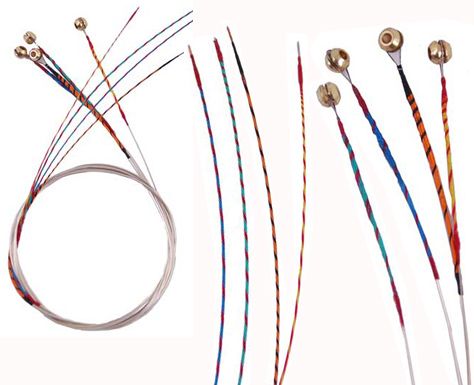
Source
The strings on the violin are made from sheep's intestines, stretched, dried, then twisted. Later it was discovered that this gut string could be developed by means of a metal alloy. The results obtained from this process are stronger and more balanced strings and because more density can be tuned with greater pressure as well. Compared to the widely used synthetic strings now, the bowel strings have a warmer sound, like the sound of a song. The many modern strings we find today use solid steel, steel or various synthetic materials. All the stringed strings and some solid strings are coated with various metals to adjust their mass, diameter, and water content. The highest E string is usually made of solid steel that is sometimes mixed with aluminum to prevent "whistle". The gold layer prevents rust on the strings and also reduces the "whistle". Stainless steel produces slightly different sounds. Synthetic core strings combine the quality of the resulting long-lasting gastrointestinal strings and adjustment stability. Strings of such materials are more sensitive to changes in moisture than intestinal strings and are less sensitive to temperature changes than metal strings.
Source: http://bekasiorchestra.blogspot.rs/p/posted-by-yasi-betta-22.html
Not indicating that the content you copy/paste is not your original work could be seen as plagiarism.
Some tips to share content and add value:
Repeated plagiarized posts are considered spam. Spam is discouraged by the community, and may result in action from the cheetah bot.
Creative Commons: If you are posting content under a Creative Commons license, please attribute and link according to the specific license. If you are posting content under CC0 or Public Domain please consider noting that at the end of your post.
If you are actually the original author, please do reply to let us know!
Thank You!
Congratulations @riefcians! You have completed some achievement on Steemit and have been rewarded with new badge(s) :
Click on any badge to view your own Board of Honor on SteemitBoard.
For more information about SteemitBoard, click here
If you no longer want to receive notifications, reply to this comment with the word
STOPCongratulations @riefcians! You have received a personal award!
Click on the badge to view your own Board of Honor on SteemitBoard.
Congratulations @riefcians! You received a personal award!
Click here to view your Board
Do not miss the last post from @steemitboard:
Congratulations @riefcians! You received a personal award!
You can view your badges on your Steem Board and compare to others on the Steem Ranking
Do not miss the last post from @steemitboard:
Vote for @Steemitboard as a witness to get one more award and increased upvotes!